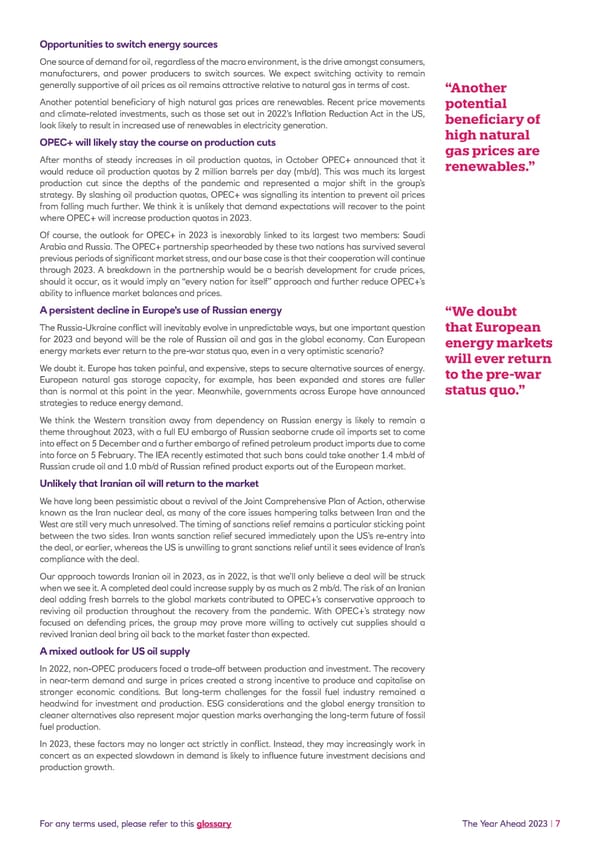Opportunities to switch energy sources One source of demand for oil, regardless of the macro environment, is the drive amongst consumers, manufacturers, and power producers to switch sources. We expect switching activity to remain generally supportive of oil prices as oil remains attractive relative to natural gas in terms of cost. “Another Another potential beneficiary of high natural gas prices are renewables. Recent price movements potential and climate-related investments, such as those set out in 2022’s Inflation Reduction Act in the US, beneficiary of look likely to result in increased use of renewables in electricity generation. high natural OPEC+ will likely stay the course on production cuts gas prices are After months of steady increases in oil production quotas, in October OPEC+ announced that it renewables.” would reduce oil production quotas by 2 million barrels per day (mb/d). This was much its largest production cut since the depths of the pandemic and represented a major shift in the group’s strategy. By slashing oil production quotas, OPEC+ was signalling its intention to prevent oil prices from falling much further. We think it is unlikely that demand expectations will recover to the point where OPEC+ will increase production quotas in 2023. Of course, the outlook for OPEC+ in 2023 is inexorably linked to its largest two members: Saudi Arabia and Russia. The OPEC+ partnership spearheaded by these two nations has survived several previous periods of significant market stress, and our base case is that their cooperation will continue through 2023. A breakdown in the partnership would be a bearish development for crude prices, should it occur, as it would imply an “every nation for itself” approach and further reduce OPEC+’s ability to influence market balances and prices. A persistent decline in Europe’s use of Russian energy “We doubt The Russia-Ukraine conflict will inevitably evolve in unpredictable ways, but one important question that European for 2023 and beyond will be the role of Russian oil and gas in the global economy. Can European energy markets energy markets ever return to the pre-war status quo, even in a very optimistic scenario? will ever return We doubt it. Europe has taken painful, and expensive, steps to secure alternative sources of energy. to the pre-war European natural gas storage capacity, for example, has been expanded and stores are fuller than is normal at this point in the year. Meanwhile, governments across Europe have announced status quo.” strategies to reduce energy demand. We think the Western transition away from dependency on Russian energy is likely to remain a theme throughout 2023, with a full EU embargo of Russian seaborne crude oil imports set to come into effect on 5 December and a further embargo of refined petroleum product imports due to come into force on 5 February. The IEA recently estimated that such bans could take another 1.4 mb/d of Russian crude oil and 1.0 mb/d of Russian refined product exports out of the European market. Unlikely that Iranian oil will return to the market We have long been pessimistic about a revival of the Joint Comprehensive Plan of Action, otherwise known as the Iran nuclear deal, as many of the core issues hampering talks between Iran and the West are still very much unresolved. The timing of sanctions relief remains a particular sticking point between the two sides. Iran wants sanction relief secured immediately upon the US’s re-entry into the deal, or earlier, whereas the US is unwilling to grant sanctions relief until it sees evidence of Iran’s compliance with the deal. Our approach towards Iranian oil in 2023, as in 2022, is that we’ll only believe a deal will be struck when we see it. A completed deal could increase supply by as much as 2 mb/d. The risk of an Iranian deal adding fresh barrels to the global markets contributed to OPEC+’s conservative approach to reviving oil production throughout the recovery from the pandemic. With OPEC+’s strategy now focused on defending prices, the group may prove more willing to actively cut supplies should a revived Iranian deal bring oil back to the market faster than expected. A mixed outlook for US oil supply In 2022, non-OPEC producers faced a trade-off between production and investment. The recovery in near-term demand and surge in prices created a strong incentive to produce and capitalise on stronger economic conditions. But long-term challenges for the fossil fuel industry remained a headwind for investment and production. ESG considerations and the global energy transition to cleaner alternatives also represent major question marks overhanging the long-term future of fossil fuel production. In 2023, these factors may no longer act strictly in conflict. Instead, they may increasingly work in concert as an expected slowdown in demand is likely to influence future investment decisions and production growth. For any terms used, please refer to this glossary The Year Ahead 2023 | 7
 NatWest Year Ahead 2023 Page 6 Page 8
NatWest Year Ahead 2023 Page 6 Page 8